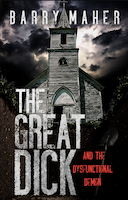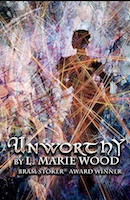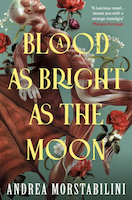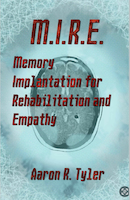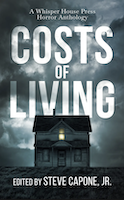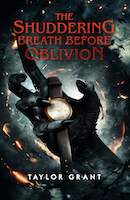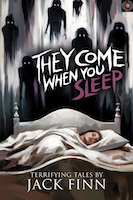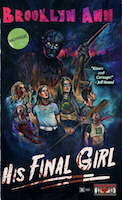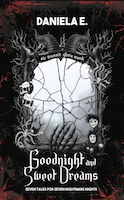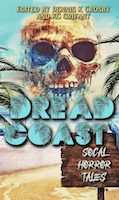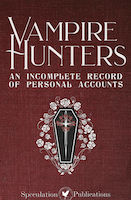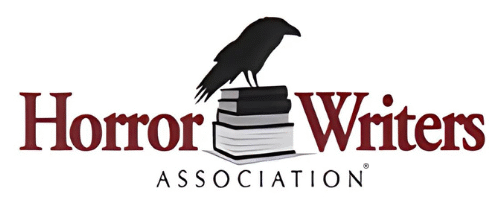CONCRETE SAVIOR by HWA Member Yvonne Navarro
Halloween Memories
 by JG Faherty
by JG Faherty
Growing up as I did in a small, rural town, Halloween was a much different experience than for people in larger towns or cities. Oh, sure, we did the usual pranks on Gate Night (or Mischief Night, if that’s what you called it), and we went around trick-or-treating until we outgrew that phase.
But there was so much more to the season.
Not 500 yards from my parents’ house was an old cemetery; so old that most of the gravestones were worn away to near-indecipherability. The few that were still readable had dates on them from the late 1700s and early 1800s. Woods had overgrown the entire back section of the cemetery, so the tombstones sprouted like gray, square funguses between the trees. Many of the plots had sunken, creating two and three-foot deep depressions in front of the head stones. I guess it was only natural that we’d come up with a game: one person would hide in the depression and we’d cover him with leaves. Then we’d find one of the younger kids in the neighborhood and bring them to the cemetery, ostensibly to let them “hang out” with the cool, older kids. We’d sit around the booby-trapped grave as the sun dipped below the horizon, turning the red and yellow and orange leaves of October to miniature flames, and we’d tell ghost stories.
And at the right moment, the kid in the grave would leap out and grab the unsuspecting victim.
If this seems cruel, remember, the older kids did it to us; that’s how we learned it.
Halloween also meant camping out in the woods and telling each other the classic horror stories: the man with the hook at lover’s lane, the road in town where cars rolled backwards at midnight, the ghostly milkman who sometimes could still be seen driving his horse-drawn cart at night. Except in our town, many of these stories were true, as were the tales of a bigfoot-like monster in the woods, the spaceships that sometimes hovered over the nuclear power plant on Hudson River (you can Google that one), and the palm tree that bled red sap on Easter Sundays (I witnessed it myself).
In a town that saw more than its fair share of violent deaths, illegal medical experiments, Revolutionary War battles, and Native American struggles, is it any wonder Halloween was a magical time for me?
About The Cemetery Club (forthcoming, January 2012)
20 years ago, four friends awoke an ancient evil living beneath the town of Rocky Point, NY. Now it’s back again, and only the Cemetery Club can stop it before the whole town is dead. Or worse.
That is the concept for my upcoming novel, THE CEMETERY CLUB. It is actually based on the assorted rumors and facts surrounding the Letchworth Village facility for the mentally disabled, which back in the 1930s also doubled as a ‘research center’ for various drugs and vaccinations, a euphemism for conducting experiments on human subjects (electroshock therapy was also widely used). The facilities are now abandoned, and will be the subject of an upcoming reality show about haunted institutions.
Being an HWA member played an integral role in my obtaining the contract to do this book. In addition to the professional aspects of being a member – garnering more attention from magazine and anthology editors, learning about contracts and other business requirements on the HWA website – the social aspects often end up being as much, if not more, important. In this case, while discussing books, contracts, and the state of the publishing industry with the owner of JournalStone Publishing at the 2011 Stoker Awards Weekend, he let it be known he was interested in expanding the number of books he wanted to put out in 2012. When I pitched him The Cemetery Club, he immediately asked me to send him the entire manuscript. Three weeks later, we worked out a contract with a professional advance and industry-standard royalties (naturally, part of my knowledge of current royalty rates came from discussions on the HWA boards). Plus, I was able to privately contact other HWA members and ask their opinions. All in all, it’s very likely I might not have ever gotten this contract if I wasn’t an HWA member.
Praise for The Cemetery Club
“The Cemetery Club is like a plastic pumpkin bucket filled to the top with all of your favorite candies. Loads of gory fun!” –Jeff Strand, author of Pressure and Dweller.
“JG Faherty nails the whole small town horror concept with a King-like flair. I definitely identified with the main characters, both past and present. All in all, I thought it was excellent.” – Michael McBride, author of Predatory Instinct and Quiet, Keeps to Himself.
“With plenty of new twists on some old favorites, Faherty’s latest novel provides readers with as much fun in a graveyard as the law will allow. Ancient legends, demonic shadow-creatures and ravenous zombies–what more could you ask for?” -Hank Schwaeble, Bram Stoker Award-winning author of Damnable and Diabolical.
TODAY’S GIVEAWAY
 JG Faherty is offering a handful of brave souls copies of Carnival of Fear and Ghosts of Coronado Bay, with one print edition and three e-book editions of each book available. To enter post a message in the comments section below or e-mail memoutreach@horror.org. Winners will be chosen at random. Contestants may enter once to be considered for all giveaways, but multiple entries are permitted.
JG Faherty is offering a handful of brave souls copies of Carnival of Fear and Ghosts of Coronado Bay, with one print edition and three e-book editions of each book available. To enter post a message in the comments section below or e-mail memoutreach@horror.org. Winners will be chosen at random. Contestants may enter once to be considered for all giveaways, but multiple entries are permitted.
JG Faherty grew up in the haunted Hudson Valley region of New York, and still resides there. Living in an area filled with Revolutionary War battle grounds, two-hundred year-old gravesites, ghosts, haunted roads, and tales of monsters in the woods has provided a rich background for his writing. A life-long fan of horror and dark fiction, JG enjoys reading, watching movies, golfing and hiking with his wife and dogs, volunteering as an exotic animal caretaker, and playing the guitar. His favorite holiday is Halloween (naturally), and as a child, one of his childhood playgrounds was an 18th century cemetery.
JG’s first novel, Carnival of Fear, was released in 2010. His next book, Ghosts of Coronado Bay, a YA supernatural thriller, was published in June 2011. The Cemetery Club, his third novel, will be released in early 2012. His other credits include more than two dozen short stories in major genre magazines and anthologies. You can visit him at www.jgfaherty.com, www.twitter.com/jgfaherty, and www.facebook/jgfaherty.
Excerpt from The Cemetery Club
Rocky Point, NY, 20 years ago
“It has to be me,” Todd Randolph said, clutching the bag to his skinny chest as the rain continued to drench the cemetery. Muddy streams cascaded alongside the blacktopped paths and cut miniature canyons between graves “I started it. I have to finish it.”
Cory Miles shook his head. “We can do it together. We should do it together. All of us. The Cemetery Club.”
John Boyd and Marisol Flores voiced their agreement. The four of them were huddled under the overhang of a mausoleum that was so old the date on the plaque couldn’t even be read through the crust of dirt and corrosion. The door stood open, exposing cobweb-covered cement casket boxes to the dim light of the stormy afternoon. In the center of the floor, a ragged hole several feet wide showed black against the gray cement. A fetid odor rose up from the darkness, death and mold and wet soil all entwined into a palpable stench that seemed bent on forcing their stomachs to turn somersaults.
“No. I’m the only one who can stop it.” Todd lowered himself into the pit, his rail-thin body disappearing from view almost immediately.
The Misunderstood Haunting
25th Anniversary Bram Stoker Award Banquet & Celebrate HWA Day
Stoker Spotlight: 13 Questions with Norman Prentiss, author of Invisible Fences
 Norman Prentiss won the 2010 Bram Stoker Award for Superior Achievement in Long Fiction for Invisible Fences, published by Cemetery Dance (www.cemeterydance.com) and recently released as an e-book. He also won a 2009 Stoker for his short story, “In the Porches of My Ears,” published in Postscripts 18. His latest book is Four Legs in the Morning, a collection of three linked stories from Cemetery Dance. Other fiction has appeared in Black Static, Commutability, Tales from the Gorezone, Damned Nation, Best Horror of the Year, The Year’s Best Dark Fantasy and Horror, and in three editions of the Shivers anthology series. His poetry has appeared in Writer Online, Southern Poetry Review, Baltimore’s City Paper, and A Sea of Alone: Poems for Alfred Hitchcock. Visit him online at www.normanprentiss.com.
Norman Prentiss won the 2010 Bram Stoker Award for Superior Achievement in Long Fiction for Invisible Fences, published by Cemetery Dance (www.cemeterydance.com) and recently released as an e-book. He also won a 2009 Stoker for his short story, “In the Porches of My Ears,” published in Postscripts 18. His latest book is Four Legs in the Morning, a collection of three linked stories from Cemetery Dance. Other fiction has appeared in Black Static, Commutability, Tales from the Gorezone, Damned Nation, Best Horror of the Year, The Year’s Best Dark Fantasy and Horror, and in three editions of the Shivers anthology series. His poetry has appeared in Writer Online, Southern Poetry Review, Baltimore’s City Paper, and A Sea of Alone: Poems for Alfred Hitchcock. Visit him online at www.normanprentiss.com.
How would you describe Invisible Fences?
I think I’d say it’s part coming-of-age story, part haunted house story. It’s also about storytelling itself, and how cautionary tales from your childhood might haunt you as an adult.
Tell us about what inspired you to write Invisible Fences?
I started with the opening metaphor of an “invisible fence,” connecting those devices that keep dogs in the yard to the stories our parents tell us to keep us close to home and safe. Once I had the central metaphor, what I expected would be a short story grew into a novella. I included a lot of materials from my life—my own parents’ cautionary tales, and the books and horror movies that my father encouraged me to love as I was growing up.
What was your writing process like for the book? Do you have a regular writing routine or schedule?
I’m a high school English teacher, and during my two summer months I treat writing as my full-time job. I wrote Invisible Fences almost exclusively at the Johns Hopkins library. I typically spend Monday-Friday at a library, away from home and Internet distractions, so I can get in a good 8 hours of writing time. I use an Alphasmart, which is essentially a dedicated word processing machine with no other programs on it—and it really helps me focus and be productive.
What most attracts you to writing horror?
I’ve always loved stories with all the expected horror tropes (haunted houses, ghosts, vampires, etc.), and the horror elements in other books that don’t call themselves horror (Shakespeare’s tragedies, 19th century novels by Dickens and Hardy and the Bronte sisters). I also think horror fits with my world view: the idea that life is not as straightforward and easy to understand as we’d like it to be. For me, horror fiction dramatizes those moments when our everyday, comfortable existence gets challenged: a spouse or family member reveals a dark secret, for example, or when nature does something unexpected and disturbing.
What are some of the themes you explore in your writing? Are there any topics you consider “out of bounds” even for horror fiction?
Love and loss are big topics for me, with a lot of my characters struggling to understand their identity. The idea of being haunted, in a psychological as well as literal sense, is a symptom of (or metaphor for) this struggle with identity. As for taboo subjects, I think part of horrors “job” is to explore taboos, so I don’t know that I’d throw any topics out of bounds for the genre itself—though there may be a few topics I wouldn’t touch in my own writing. But then, even as I’m trying to come up with my own taboo subjects, I start to think, “if the story were good enough, maybe…”
What are you writing now?
I’m working on another Dr. Sibley story, continuing with the character I created for my recently announced book from Cemetery Dance (Four Legs in the Morning; the title story from that collection is available as a free e-book from the publisher). I’m also working on a novel, the first part of which contains several queer pulp-style adventures that would work as standalone stories—but there’s an overall framework that puts the stories into a larger, more meaningful context. That’s the plan, at least!
What do you see as horror literature’s role in contemporary culture?
I think horror will always have a double role. One role is to be a “thrill ride”—the safe space where we can have fun confronting our fears, some scares and maybe a little nervous laughter along the way. The other role is for horror to remind us of the darkness we’d rather ignore—to disturb us even after we’ve closed the book, maybe help readers prepare for the worst that could happen.
Tell us about an experience or experiences with the HWA that influenced your writing or helped you as a writer.
The thing I’m most impressed by is the openness of the horror community, which the HWA exemplifies. As writers, we may be aiming for the same limited slots in an upcoming anthology, for example, but there’s a genuine sense of mutual encouragement rather than competition. That helps a lot, because writing can be such an isolating experience (I’m thinking of my 8 hour library days during the summer months!), and it’s good to share in and celebrate everyone’s successes.
What advice would you share with new horror writers? What do you think are the biggest challenges most writers face?
My best advice would be not to rush to publication. Any great story that’s out there with your name on it is strong publicity for your other writing—but if a story’s weak, it makes a bad first impression on readers.
The biggest challenges most writers face have to do with the changing options for publication. The traditional advice doesn’t necessarily work anymore. Although it seems like a positive outcome of electronic publishing, it may actually be too easy to make your work available for readers. The best writing should stand out, though, no matter how it finds its readers.
What are three of your favorite horror stories?
- M. R. James, “Casting the Runes”
Douglas Clegg, Neverland
T. M. Wright, Cold House (a novel, also available as part of his Bone Soup collection)
What’s your favorite Halloween memory or tradition?
When I was about 12, a local dentist gave out toothpaste instead of candy. My brother and I emptied the tubes onto his sidewalk, walked a few steps and saw a bunch of other kids had gotten the same revenge.
Given a choice, trick? Or treat?
A trick is usually more memorable, so I’ll go with that.
Who would win in a fight—Bigfoot or Yeti?
Bigfoot, because of the toenails.
 Excerpt from Invisible Fences by Norman Prentiss
Excerpt from Invisible Fences by Norman Prentiss
There’s an invention for today’s dog owners called an invisible fence. It’s basically a radio signal around the perimeter of the yard, and if the dog steps too close to the signal, it triggers a device in the animal’s collar and delivers a small electrical shock. Perfect Pavlov conditioning, just like I learned back in ninth grade psychology class. But it seems a bit cruel to me. The dog’s bound to be zapped a few times before it catches on. Dogs aren’t always as quick as we are. Hell, growing up we had a mongrel lab that would probably never have figured it out: Atlas would have barked at air, then -zap!-. Another bark and charge then -zap!- again. I loved that sweet, dumb animal.
Still, I guess for most dogs the gadget would work eventually. Inflict a little pain and terror at the start, and then you’re forever spared the eyesore of a chain-link fence around your front lawn.
#
“The Big Street”
When I was growing up, my parents invented their own kind of invisible fence for me and my sister. All parents build some version of this fence—never talk to strangers, keep close to home after sundown, that kind of thing. But my parents had a gift with words and storytelling that zapped those lessons into my young mind with a special permanence.
My father taught Shop—excuse me, Industrial Arts—at Kensington High School, so I guess that’s where he built up his skills with the cautionary tale: don’t feed your hand into the disc sander; keep your un-goggled eyes away from the jigsaw blade, and other Greatest Hits. But listen to his rendition of that old stand-by, “The Big Street”:
He walked me and my sister Pam to the divided road on the north end of our community. I was six, and Pam was three years older. He stopped us at the curb of McNeil Road, just close enough where we could hear the cars zip by, feel the hot wind of exhaust or maybe get hit by a stray speck of gravel tossed up by a rear wheel. A half-mile down, on the other side of McNeil, was a small shopping center: a single screen movie theater, Safeway grocery, People’s Drugs, and a Dairy Queen, among other highlights. In the other direction visible from the top of this hill was Strathmore Park, with swings, monkey bars, and a fiberglass spider with bent-ladder legs. We could visit these wondrous places anytime dad drove us there, but we were never, ever, to cross the Big Street on our own.



